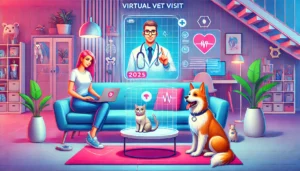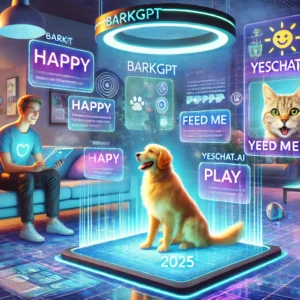
Have you ever found yourself panicking in the middle of the night because your dog was limping or your cat wouldn’t stop meowing? These days, you don’t necessarily have to hop in the car and rush to a clinic. Thanks to virtual vet visits, telemedicine for pets is surging in popularity, making it possible to receive professional guidance without leaving home. But how does pet telemedicine actually work, and why is it becoming such a big deal in 2025? Let’s explore the ins and outs of this exciting new trend—from government regulations and political debates to real-life stories, celebrity endorsements, and the economic landscape behind it all.
H2: What Are Virtual Vet Visits?
Virtual vet visits involve using technology—video calls, phone consultations, or even app-based messaging—to connect pet owners with veterinary professionals remotely. Companies like HappyDoc.ai and Guardian Vets have made it easier for anxious pet parents to access expert advice 24/7. Often, these online platforms allow:
- Live video chats: Vets can see your pet’s condition in real-time.
- Secure messaging: Share photos, chat, and get immediate feedback.
- Prescription management: Some telemedicine services work with local pharmacies to handle medication needs.
- Follow-up scheduling: Virtual follow-ups ensure continuity of care.
This isn’t just for emergencies. Virtual vet visits help with minor issues like dietary consultations, behavioral questions, or general wellness checks. For more severe cases, vets can swiftly determine if an in-person visit is needed.
H2: Why Telemedicine for Pets Is Trending
Even before 2025, telehealth for humans was on the rise. Then, the push for digital solutions accelerated, and pet healthcare was not far behind. The biggest advantages:
- Convenience: You can chat with a vet from your living room while your cat naps on your lap.
- Cost-Efficiency: Virtual consultations often come at a lower cost than a full clinic visit.
- Increased Access: Owners in remote areas can connect with specialists they’d never find locally.
- Less Stress for Pets: Avoiding the car ride and unfamiliar environment helps reduce pet anxiety.
According to Netmeds.com, a growing number of clinics are integrating telehealth features into their regular practice, responding to an ever-increasing demand for remote pet care.
H2: Government and Political Perspectives
In various parts of the world, governments are paying closer attention to the rise of virtual vet visits. Some key points:
- Regulatory Frameworks: The U.S. Food and Drug Administration (FDA) and state-level veterinary boards have introduced guidelines about prescribing medications via telemedicine. These rules are evolving, with many states updating laws to permit more comprehensive remote vet care.
- Debates Over Licensing: Politicians often engage in fiery debates over whether a vet must be licensed in the state where the pet resides. Proponents argue telemedicine should be accessible across state lines to expand care. Critics worry about oversight and accountability.
- European Initiatives: In the EU, telemedicine for pets has become a hot topic, especially with borderless healthcare provisions. Some member states are enthusiastic about digital transformation in veterinary medicine, while others remain skeptical about potential malpractice risks.
Governments are also exploring ways to ensure rural communities, many of which struggle with limited veterinary services, can benefit from remote vet solutions. The conversation isn’t always smooth—some lawmakers argue that telemedicine might reduce in-person checkups, potentially overlooking complex diagnoses. Others see it as an efficient expansion of healthcare.
H2: Scientific Research and Veterinary Labs
Leading veterinary research labs worldwide, such as the Waltham Petcare Science Institute and university-based vet hospitals, are studying the effectiveness of telemedicine for animals. Some intriguing findings include:
- Diagnostic Accuracy: Preliminary research suggests that for simple conditions—like minor skin rashes or nutritional advice—remote vets are just as effective as traditional consultations.
- Technology Gaps: Not all pet owners have high-speed internet or advanced video devices. Labs are working on more robust, user-friendly platforms to ensure digital consultations remain accessible.
- Behavioral Analysis: Some ongoing experiments investigate AI-driven software that could detect subtle cues in a pet’s posture or voice patterns during a virtual consult. It’s futuristic, but real: imagine an app analyzing your dog’s bark pitch to suggest potential health concerns!
One lab veterinarian, Dr. Elena Vasquez, points out:
“We’re seeing that telemedicine is not just a convenience tool—it can drive better preventive care. Our remote follow-ups show an uptick in vaccinations and routine screenings. People are more willing to check in with a vet if it’s just a few clicks away.”
H2: Celebrity Endorsements in 2025
Celebrities are embracing virtual vet visits, often sharing experiences on social media. Taylor Swift, an outspoken cat lover, recently posted about using a telemedicine service for a late-night feline emergency. Similarly, actor Chris Evans has been spotted endorsing remote vet apps for routine check-ups on his rescue dog, Dodger. These high-profile stories inspire fans to explore telemedicine for their own pets.
Beyond star endorsements, popular culture fosters a more open-minded view of digital solutions. Influencers on TikTok, for example, record Q&A sessions with vets, bridging the gap between professional advice and everyday pet antics. These viral videos are accelerating the acceptance of remote care among younger pet owners.
H2: Older Pet Owners’ Perspective
Skepticism often arises among older adults who are less accustomed to digital healthcare. Some might worry it’s impersonal or question if a vet can truly diagnose an issue without physically examining the pet. However, older generations are finding that telemedicine can simplify routines, especially if mobility is an issue or the nearest vet clinic is far away.
“My arthritis makes driving tough,” says Martha, a 72-year-old cat owner. “I was anxious when my cat started limping, and I couldn’t easily get to the vet’s office. A quick video call reassured me it was only a minor sprain. Now I’m convinced technology can help people like me.”
This demographic is often pleasantly surprised by how user-friendly virtual platforms can be. Some services even offer step-by-step assistance to guide older adults through signing up and booking appointments.
H2: Younger Generations and Digital Pet Parenting
For Gen Z and Millennials, the notion of consulting a vet via smartphone is second nature. In a world where everything from groceries to therapy is just a swipe away, having a vet on speed dial fits neatly into a fast-paced lifestyle. Younger pet owners look for immediacy and convenience, prioritizing telemedicine solutions that:
- Integrate with mobile apps for scheduling and reminders.
- Offer text-based support alongside video calls.
- Provide membership plans or subscriptions for unlimited consults.
Social media-savvy individuals also enjoy sharing their telemedicine experiences, often snapping screenshots of virtual vet sessions (with the vet’s permission) and posting them online. This further normalizes the practice, encouraging more young people to jump on board.
H2: Global Market and Financial Outlook
The telemedicine market for pets is booming worldwide. Analysts predict that by 2030, it could become a multi-billion-dollar segment of the broader pet healthcare industry. Factors fueling this growth include:
- Venture Capital Investments: Startups specializing in virtual vet services are attracting significant capital, evidenced by expansions of platforms like VirtualVetCare.vet.
- Partnerships and Mergers: Traditional vet chains are merging with telehealth platforms to reach new markets and provide one-stop solutions.
- Revenue Streams: Beyond consultation fees, companies are monetizing subscription services, online pharmacies, and targeted telehealth plans for chronic conditions.
Even in emerging markets—across Asia, Africa, and Latin America—there’s growing interest in remote vet solutions. Government-led initiatives to boost internet infrastructure in rural areas are opening doors for telemedicine, making it a viable solution in regions historically underserved by in-person veterinary care.
H2: Political Discourse and Policy Challenges
Telemedicine for pets hasn’t escaped political debate. Issues include:
- State vs. Federal Oversight: In the U.S., some lawmakers argue that a federal framework is necessary to standardize telehealth for pets. Others push for states to retain authority, fearing one-size-fits-all policies.
- Data Privacy: As telemedicine platforms handle medical data, including prescriptions and sensitive pet health information, concerns arise over data breaches. Politicians want stronger digital security measures and compliance with existing medical privacy laws.
- Accessibility Laws: Activists highlight the need for accessible telehealth platforms for visually or hearing-impaired individuals and those with limited tech literacy. Inclusive design has emerged as a focal point in policy discussions.
Meanwhile, certain industry groups lobby for relaxed regulations on cross-border telemedicine. They argue that a vet in one country might effectively treat a pet in another if licensed or certified under international guidelines, though critics warn of oversight complexities and potential exploitation.
H2: Potential Downsides and Limitations
While virtual vet visits are transformative, they aren’t without challenges:
- Physical Exams: Some diagnoses require a hands-on approach—palpating an abdomen, inspecting a wound in detail, or conducting lab tests that simply can’t be done virtually. Telemedicine, therefore, works best for follow-ups, minor issues, or initial triage.
- Technology Hurdles: Poor internet connectivity or low-quality cameras can hamper a vet’s ability to assess a pet’s condition accurately. This remains a significant hurdle in rural or underprivileged areas.
- Lack of Personal Connection: Some pet owners miss the personal touch of an in-clinic visit, where vets and pets can interact in a comforting environment.
- Regulatory Uncertainty: Rapidly shifting regulations in different countries and states can create confusion over what’s permissible, causing hesitation among new telehealth providers.
In the face of these obstacles, telemedicine companies are innovating. Many platforms use AI-driven diagnostics to compensate for lower-quality images, while government bodies worldwide are working toward clearer guidelines to ensure consistent standards.
H2: Real-Life Success Stories
- Midnight Emergency: Lucy, a college student with a Husky, discovered a rash on her dog at 2 AM. A frantic Google search led her to a telemedicine app. A vet diagnosed the rash as a mild allergic reaction, recommended an over-the-counter lotion, and advised a follow-up if it didn’t improve. The condition resolved in a few days.
- Rural Support: In remote parts of Montana, telemedicine became a lifeline for a small farming community. The nearest vet clinic was an hour’s drive away. Through a local co-op, the community gained access to a virtual vet who offered monthly check-ups for working dogs and farm cats. This minimized travel and improved overall pet health.
- Cost-Effective Care: After adopting a senior rescue cat, single mom Olivia worried about constant vet bills. She enrolled in a membership plan through a telemedicine provider, reducing her in-person vet visits. She now uses video consults for routine matters, saving money and travel time.
These personal anecdotes highlight how telemedicine can fit seamlessly into diverse lifestyles while supporting better, more immediate pet care.
H2: Tips for Pet Owners Considering Telemedicine
- Check Credentials: Ensure the platform employs licensed veterinarians in your state or country.
- Know the Limitations: Use telemedicine for minor issues or routine follow-ups. Seek in-person care for urgent or complex cases.
- Prepare Information: Have your pet’s medical records, recent photos, or videos ready to share. Clear visuals can help your virtual vet make an informed assessment.
- Stay Connected: Reliable internet and a well-lit, quiet space during the video call can significantly improve your vet’s ability to see and hear your pet.
- Follow Post-Consult Instructions: Many telemedicine services offer digital records or summaries. Keep track of recommended treatments, medications, or follow-ups.
Frequently Asked Questions (FAQs)
Q: Can a virtual vet prescribe medications?
A: Yes, in many regions, vets can prescribe medications after conducting a telehealth consultation. However, regulations differ by state or country, so check your local laws.
Q: Is telemedicine a replacement for regular vet visits?
A: It can’t entirely replace physical exams and advanced diagnostics, but it’s a convenient supplement for minor concerns or general advice.
Q: How do I ensure my pet stays calm during a video call?
A: Treats and a comfortable, familiar environment help. Position yourself in a quiet room, and keep your pet relaxed with gentle reassurance.
Q: Are virtual vet services covered by pet insurance?
A: Some insurance companies are beginning to cover telemedicine, but it varies. Contact your provider to confirm.
Q: What if the connection drops mid-consult?
A: Most platforms have backup methods—like phone calls or messaging—so you can continue discussing your pet’s issue.
H2: Looking Ahead: Telemedicine’s Future in Pet Healthcare
As we edge deeper into 2025, virtual vet visits appear poised for further growth. Consider these possibilities on the horizon:
- Wearable Pet Tech: Imagine a collar that measures heart rate, temperature, and respiration, sending real-time data to your vet. This could transform how routine check-ups and emergency diagnostics happen.
- AI-Assisted Diagnoses: Artificial intelligence is evolving rapidly. Algorithms that scan video feeds to detect subtle signs of distress or disease in pets may soon become the norm.
- Integrated Healthcare Ecosystems: Pet telemedicine might merge with human telehealth platforms, offering holistic solutions under one digital roof. Families could track health data for both two- and four-legged members simultaneously.
- Public-Private Partnerships: Governments could partner with private companies to expand telemedicine access in underserved areas, offering free or subsidized telehealth consultations to pet owners in rural regions.
The overarching takeaway? Telemedicine is more than a buzzword. It’s shifting the landscape of pet healthcare, driven by convenience, cost-effectiveness, and evolving technology. Although traditional clinics will always remain essential for hands-on treatments and surgeries, virtual vet visits fill a critical gap in accessible care, particularly for minor ailments or preliminary consultations.
Final Thoughts and Next Steps
If you haven’t tried telemedicine for your pet, now might be the perfect time to explore it. Platforms like HappyDoc.ai and VirtualVetCare.vet are just a few clicks away. Whether you’re a busy professional, a rural dweller, or simply seeking a stress-free approach to pet healthcare, virtual vet visits can provide peace of mind with minimal hassle.
Ready to learn more? Check out our other articles on emerging pet health technologies, subscribe to our newsletter for the latest updates, or share your own telemedicine experiences in the comments below. Your pet—and your wallet—might just thank you for it.




